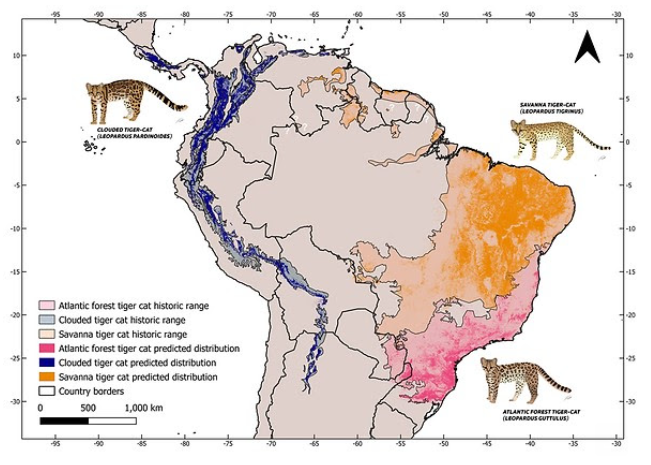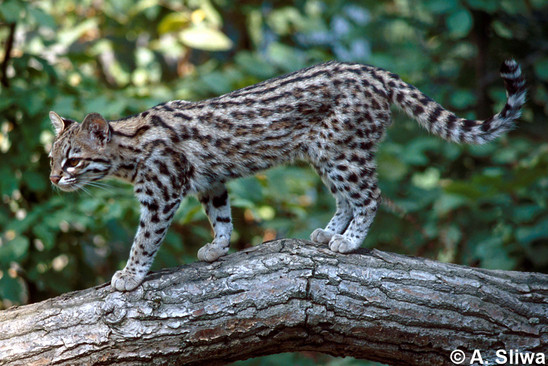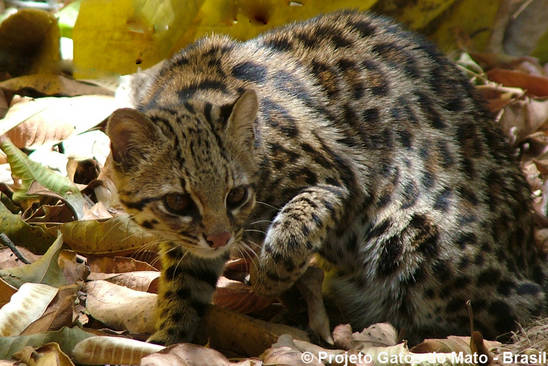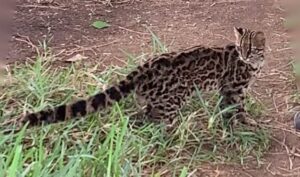Species complex: a group of closely related organisms that are so similar in appearance and other features that the boundaries between them are often unclear.
One of the smallest spotted cats in South America has always been a bit of a mystery. They have been referred to as Oncillas, Tigrinas, Small-spotted cats, Tigrillos, Little-spotted cats or Tiger Cats. In 2013 after genetic testing, the Oncilla was split into two species referred to as either Southern Tiger Cats Leopardus guttulus or Northern Tiger Cats Leopardus tigrinus.
And then along came Tadeu de Oliveira and the Tiger Cats Conservation Initiative (TCCI) in Brazil.
The team examined 1,400 records from museums and camera traps, allowing them to compare sizes, shapes, and color patterns among tiger cats, as as well as determine the habitats where each species lives. They also analyzed the clouded tiger cat’s genetics to make an airtight case for its species status.
Principal component analysis showed three clearly distinct groups:
Savanna Tiger cat Leopardus tigrinus The Tigrinus group of the savannas of central and northeastern Brazil
Atlantic Forest Tiger cat Leopardus guttulus The guttulus group of the lowland forests of the Atlantic Forest domain
Clouded Tiger cat Leopardus pardinoides The pardinoides group of the cloud forests of southern Central America and Andean mountains

Tiger cats are daintily built cats, with a narrow head and a white line above the eyes. The large ears have a black backside with a central white spot. The irises are golden or light brown. Males are slightly, but significantly, larger than females. Averaging just 2-3 kg, some individuals are even smaller, weighing only 1.8 kg while others are large with a weight of 3.5 kg.
Ecology
Tiger Cats are solitary felids. They are active predominantly at night, but can also show varying degrees of diurnal activity. This activity during any time of the day is suggested to be a strategy to avoid the Ocelot. On the other hand, Tiger cat numbers are not affected by the presence of the Margay and Jaguarundi, which are more likely potential competitors for similar sized prey.
They are excellent climbers, but spend most of their time on the ground as most of their prey is terrestrial. When threatened, they show an aggressive behavior with arched back and raised hair, besides showing the teeth and producing a “whistling-spitting” vocalization.
The Tiger cat’s diet is still very poorly studied, but is known to be based on small mammals, birds and reptiles (especially lizards). It is likely this small felid is a generalist predator, taking advantage of the most readily available resources in the area.
Reproduction
Very little information about the Tiger cat’s reproduction in the wild is available. Reproduction occurs year round, but could show different peaks in different areas. The gestation period lasts for 75-78 days, after which 1-3 kittens are born, but the normal litter is one kitten. The eyes are open at 8–17 days. Weaning occurs at two to three months and young are about adult body size at 11 months of age.
However, sexual maturity is achieved only at about 2-2.5 years, which is rather late for a felid this size. The lifetime number of young potentially produced by a 7 year old female Tiger cat in the wild is generally up to 5. This shows a very low reproductive potential, considering its small size, especially when compared to other felids from other continents. Longevity in captivity is reported as 15-21 years.
Threats
Habitat loss and fragmentation;
Diseases from domestic dogs and cats;
Poaching/retaliatory killing;
Road-kills;
Extensive fires;
Pet trade
The Ocelot Effect
As a generalist carnivore and the largest and most adaptable of the small cat species in tropical America, the Ocelot Leopardus pardalis dominates the other small cat species. In areas where the Ocelot occurs above a certain population threshold, species like the Tiger Cat avoid those areas because of the threat of predation. When Ocelot population numbers are low there is no negative effect on small cat numbers. Where Ocelots inhabit protected areas, the smaller cats can be forced into unprotected areas where the threat of habitat loss and human interaction is greater.
Conservation
Despite the happy news of a new species, the scientists likewise uncovered a grim reality—each tiger cat exists in far fewer places than once believed. They’ve lost more than 50 percent of their original area.
Tiger cats everywhere are under imminent threat of losing their habitats to agriculture and development. And pathogens, such as canine distemper virus, have the ability to spill over from domestic animals. Also unfortunate is the fact that most tiger-cat populations exist outside of protected areas
See Tiger Cats Conservation Initiatives Actions Page for ways to help the cats
Savanna Tiger Cat Leopardus tigrinus (formerly Northern Tiger Cat)
- Head Body Length: 48.2 cm (19″)
- Tail Length: 27.8 cm (10.9″)
- Weight: 2.32 kg (5.1 lbs)
- Height: approx. 20 cm (8″)
- Population: Decreasing and Vulnerable
Slender, long legged body. Long thin tail, proportionally large ears.
Background yellowish, greyish yellow. Spots are small open rosettes, or solid dot-like rosettes that may tend to merge.
Habitat
The Savanna Tiger cat lives in a wide range of forest habitats, semi-arid thorny scrub, savannah and wet/swampy savannah. In Central and northwestern South America, it is mainly associated with montane cloud forests, where it is usually found at higher elevations than the Ocelot and Margay. The Savanna Tiger cat occurs up to an elevation of 1,245 m. In Brazil it is commonly associated with savannah, semi arid scrub and to a minor extent to forests.
In the Amazon, the species is restricted mostly to the savanna enclaves formations in the Guiana Shield but is absent in the varying types of Amazonian rainforest formations. It was recently shown that ocelot density and proximity to savanna formations determine the presence of L. tigrinus in Amazonia.
It can be found in disturbed habitats, even close to human settlements, as long as there is natural cover and prey base.
Atlantic Forest Tiger cat Leopardus guttulus (formerly Southern Tiger Cat)
- Head Body Length: 51 cm (20″)
- Tail Length: 27.2 cm (10.7″)
- Weight: 2.38 kg (5.2 lbs)
- Height: approx. 20 cm (8″)
- Population: Decreasing and Vulnerable
Slightly bulky body, medium large bushy tail, proportionately smaller ears.
Background redness/brownish or yellowish tone. Spots are large and numerous round rosettes, very rarely tending to merge
Habitat
The Atlantic Tiger cat occurs in a variety of habitats within the Atlantic forest domain, from dense tropical and subtropical rainforests, deciduous/semi-deciduous, and mixed pine forests, to the beach vegetation. They also inhabit disturbed areas such as forest fragments in an agricultural landscape where there is an abundance of rodents but its occurrence is limited by the presence of natural cover. Both telemetry information and scat analysis indicate the cats do not venture into the agricultural fields but only use their borders. Rodent abundance is increased in these areas. Known altitudinal range of the Atlantic Tiger cat is below 2,000 m.
Clouded Tiger cat Leopardus pardinoides
- Head Body Length: 48.5 cm (19″)
- Tail Length: 29cm ((11.4″)
- Weight: 2.27 kg (5) lbs
- Height: approx. 20 cm (8″)
- Population: Decreasing and Vulnerable
Long, margay-sized bushy tail, short rounded ears and margay-ish looking head.
Background rich reddish/orange, greyish/yellow. Spot are irregularly shaped, strongly marked medium to large cloudy rosettes that sometimes merge.
Habitat
The Clouded Tiger cat ranges along 11 mountain ecoregions. In Central America, it is restricted to the Tilarán, Central Volcanic, and Talamanca cordilleras of Costa Rica and Panama and the eastern Panamanian montane forests. In South America, the range extends from the Venezuelan Andean forests through the eastern, central, and western cordilleras of Colombia, into Ecuador, all the way through the Peruvian, Bolivian, and Southern Andean Yungas forests ecoregions, and ends in northwest Argentina. The core area of its distribution lies in Colombia, but extends into Ecuador. Thus, it becomes clear that L. pardinoides is the tiger-cat species of the cloud forests of the southern Central American and Andean mountain chains.
Altitudinal range is typically above 1,500 metres, especially between 2,000 and 3,000 m, and can reach up to 3960 m.
Read more
Ecological modeling, biogeography, and phenotypic analyses setting the tiger cats’ hyperdimensional niches reveal a new species de Oliveira, T.G., Fox-Rosales, L.A., Ramírez-Fernández, J.D. et al. Sci Rep 14, 2395 (2024)
Tiger Cat Conservation Initiative (TCCI)
Updated 2024
